Highlighted Research
This page gives a preview of some of our group's highlighted research. For more information on our group's research, feel free to check our publications page and/or feel free to contact us! We are always interested in discussing interesting ideas and pursuing new collaborations.
Recent Research
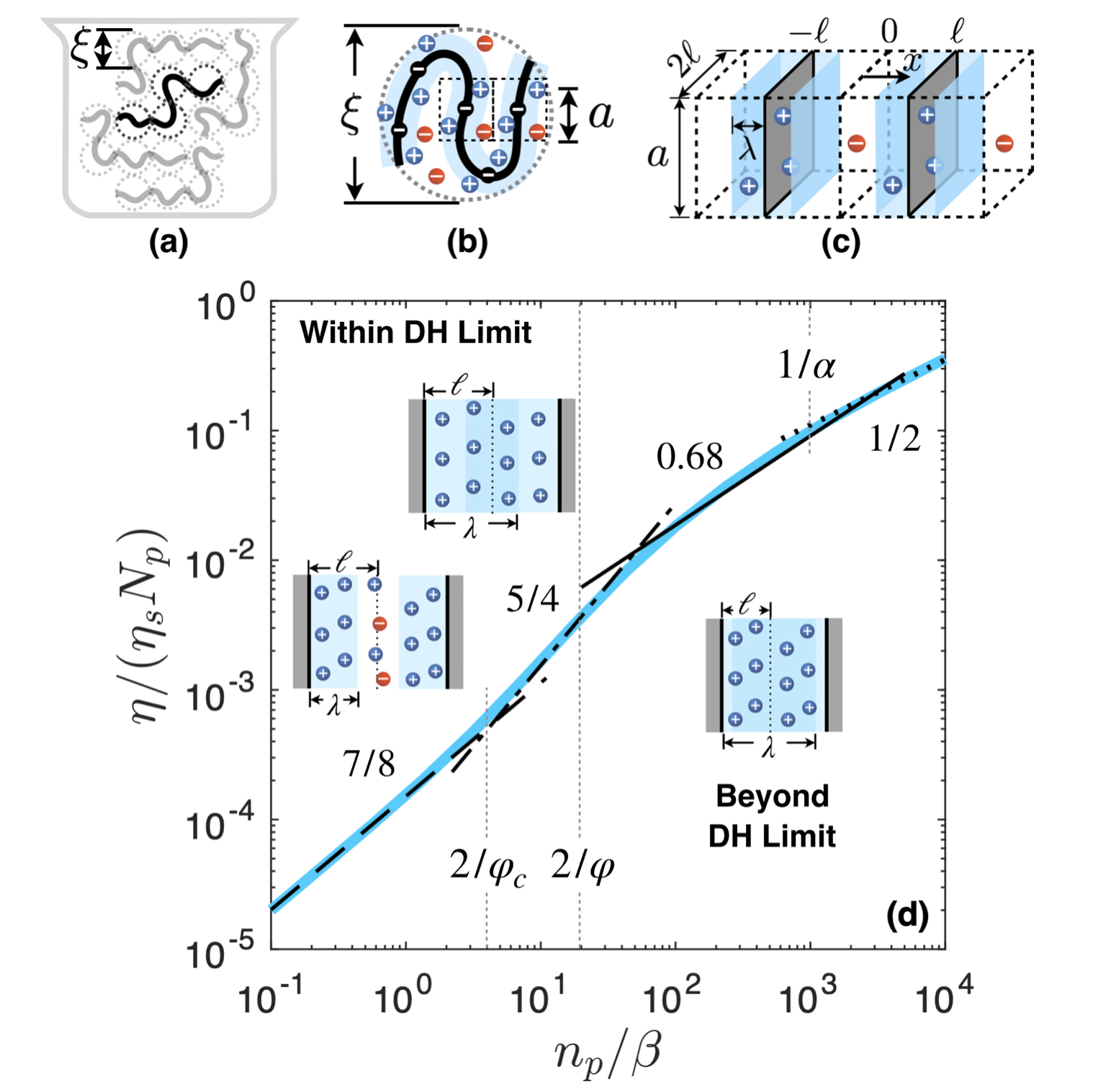
Influence of Salt on the Viscosity of Polyelectrolyte Solutions
Researchers: Guang Chen, Antonio Perazzo, and Howard A. StoneAbstract: Polyelectrolytes (PEs) are charged polymers, such as DNA, RNA, and many other biological molecules that are ubiquitous in nature. PE solutions are endowed with viscoelastic behavior and are widely applied in energy storage, oil recovery, the food industry, and cosmetics. However, due to the electrostatic interactions among the charged monomers and mobile ions, the dependence of the rheological properties on the polymer concentration np of PE solutions differs significantly from that of solutions of uncharged macromolecules. In addition, salt in PE solutions, whether added intentionally or intrinsically present, can affect the properties of the solutions. In this work, we introduce cell models to understand the electrostatics and its contribution to the conformation and rheology of PE solutions (a-c). By incorporating the electrostatic interactions into the blob model and Zimm-Rouse dynamic model, we identify four consecutive regimes dependent on the magnitude of the ratio of the polymer concentration to the salt concentration np/&beta (d), which capture the unexplained experimental data. With our theory, we anticipate that the empirical Fuoss’s law is expected for solutions prepared with salt-contaminated PE samples. A new critical charge fraction is defined, where we predict that the peak, which is present in the measurements of the reduced viscosity as a function of np, is only expected for weakly charged PEs prepared with pure PE samples. We expect that our approach can be useful for future investigations on the electrostatics in charged colloidal systems, such as clay particle suspensions and bacterial colonies.
Publications: G. Chen, A. Perazzo, and H. A. Stone, Phys. Rev. Lett., 124, 177801 (2020)
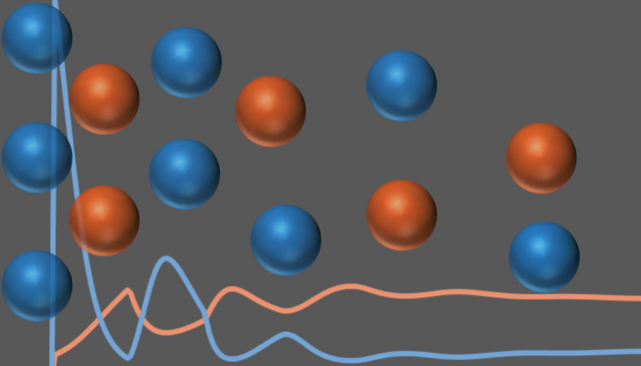
Ionic layering and overcharging in electrical double layers in a Poisson-Boltzmann model
Researchers: Ankur Gupta, Ananth Govind Rajan (IISc Bangalore), Emily A. Carter (UCLA), Howard A. StoneAbstract: The arrangement of cations and anions near a charged surface plays a pivotal role in a broad range of applications such as energy storage, environmental remediation, lab-on-a-chip devices, and biophysics. Typically, this arrangement of ions is modeled through Poisson-Boltzmann (PB) models that predict the spatial dependence of the electric potential and ion concentrations. Though PB models are widely used due to their analytical simplicity and computational ease, they are unable to predict any oscillations in ion concentrations, which are usually observed in molecular simulations. Here, we capture these details of ion concentration oscillations within a PB model by incorporating the nonlocal interactions that arise due to finite ion size and show that our model is in quantitative agreement with more computationally intensive approaches (integral equation theories, Monte Carlo, and molecular dynamics). Our analysis directly advances the understanding of several key topics at the forefront of physics and chemistry, e.g., the overcharging phenomenon, the structure of ionic liquids, and colloidal stability, among others.
Publications: Ionic layering and overcharging in electrical double layers in a Poisson-Boltzmann model, Phys. Rev. Lett. Ankur Gupta, Ananth Govind Rajan, Emily A. Carter, and Howard A. Stone
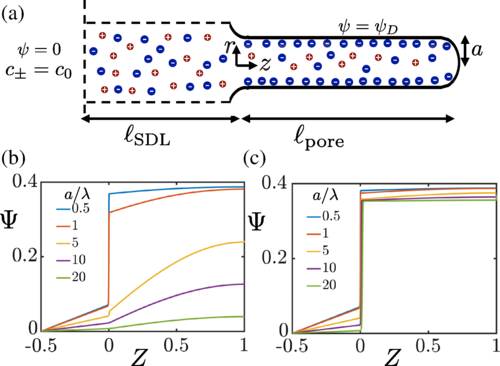
Charging Dynamics of Overlapping Double Layers in a Cylindrical Nanopore
Researchers: Ankur Gupta, Pawel Zuk (Polish Academy of Sciences), Howard A. StoneAbstract: The charging of electrical double layers inside a cylindrical pore has applications to supercapacitors, batteries, desalination and biosensors. The charging dynamics in the limit of thin double layers, i.e., when the double layer thickness is much smaller than the pore radius, is commonly described using an effective RC transmission line circuit. Here, we perform direct numerical simulations (DNS) of the Poisson-Nernst-Planck equations to study the double layer charging for the scenario of overlapping double layers, i.e., when the double layer thickness is comparable to the pore radius. We develop an analytical model that accurately predicts the results of DNS. Also, we construct a modified effective circuit for the overlapping double layer limit, and find that the modified circuit is identical to the RC transmission line but with different values and physical interpretation of the capacitive and resistive elements. In particular, the effective surface potential is reduced, the capacitor represents a volumetric current source, and the charging timescale is weakly dependent on the ratio of the pore radius and the double layer thickness.
Publications: Charging Dynamics of Overlapping Double Layers in a Cylindrical Nanopore, Phys. Rev. Lett. 125, 076001. Ankur Gupta, Pawel J. Zuk, and Howard A. Stone
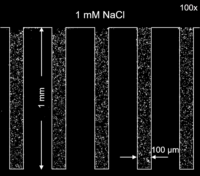
Dead-end pore geometries for the study of electrolyte diffusion and diffusiophoresis
Researchers: Ankur Gupta, Suin Shim, Ben Alessio, Jessica L. Wilson, Luqman Issah, Emmanuel Mintah, Estella Yu, and Howard A. StoneAbstract: We utilize a dead-end pore geometry to study electrolyte diffusion and diffusiophoresis of charged particles. Diffusiophoretic mobility of a charged particle is a function of surface zeta potential and can be approximated as a constant for an ideal limit of fixed zeta potential and a thin double layer. For dilute electrolytes, the finite double layer thickness effects are significant, and for concentrated electrolytes, charge screening could result in a decrease in the diffusiophoretic mobility. Using the same geometry, we study diffusiophoresis of polystyrene particles under a concentration gradient of multivalent ions and in multiple-ion systems.
Publications: A. Gupta, S. Shim and H. A. Stone, “Diffusiophoresis: from dilute to concentrated electrolytes” Soft Matter, 2020, 16, 6975-6984 https://doi.org/10.1039/D0SM00899K;
J. L. Wilson, S. Shim, Y. E. Yu, A. Gupta and H. A. Stone, “Diffusiophoresis in multivalent electrolytes” Langmuir, 2020, 36, 7014-7020 https://doi.org/10.1021/acs.langmuir.9b03333;
A. Gupta, S. Shim , L. Issah, C. McKenzie and H. A. Stone, "Diffusion of multiple electrolytes cannot be treated independently: model predictions with experimental validations” Soft Matter, 2019, 15, 9965-9973 https://doi.org/10.1039/C9SM01780A
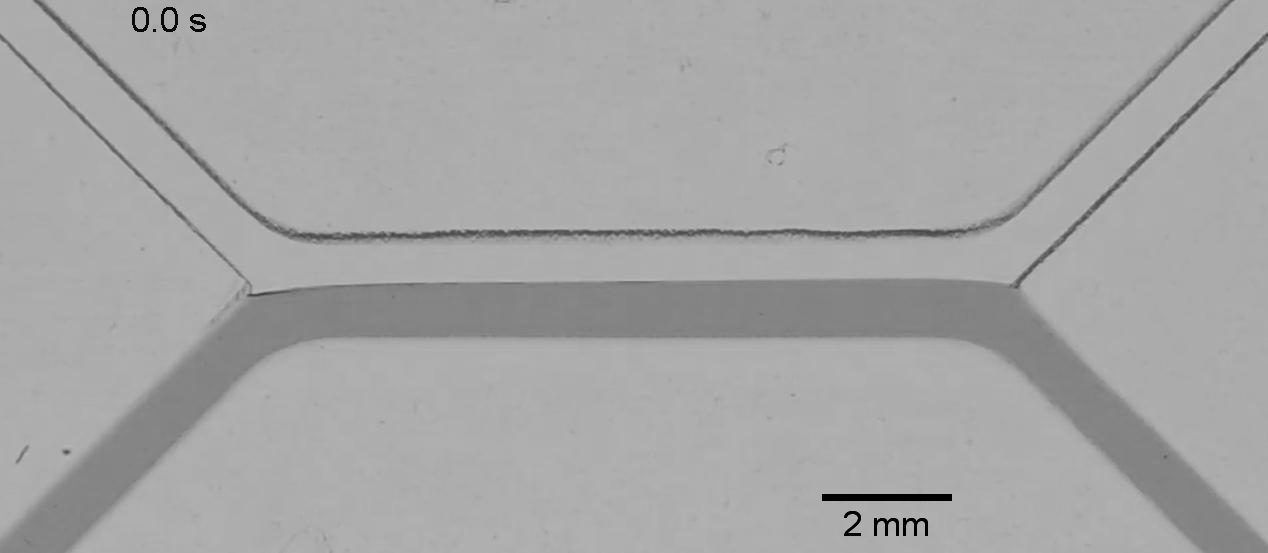
Symmetry breaking in a parallel two-phase flow
Researchers: Paul R. Kaneelil, Amir A. Pahlavan, Miguel A. Herrada, Kristen LeRoy, Kylie Stengel, Samuel Warner, Anna M. Galea, Howard A. StoneAbstract: Parallel two-phase flows are omnipresent in technological applications that require contact between two immiscible fluids for a finite amount of time. Precise control over the flow and separation of the fluids once they have been in contact are therefore the key challenges in these applications. Here, using experiments and numerical simulations, we show that the interface between two immiscible fluids flowing at the same flow rate in a symmetric channel can become unstable locally near the exit junction, where the two fluids are separated. This instability leads to the shedding of the droplets of one phase into the other, preventing a complete separation. We characterize this instability and show that the period of drop shedding is inversely proportional to the flow rate. We derive a stability criterion based on the balance between the Laplace pressure across the liquid-liquid interface and viscous pressure drop along each flow stream. The stability criterion and our experimental results are used to highlight the extreme sensitivity of this flow system to the parameters involved such as viscosity difference and exit geometry, which introduces gravitational effects and characteristics of the exit tubing.
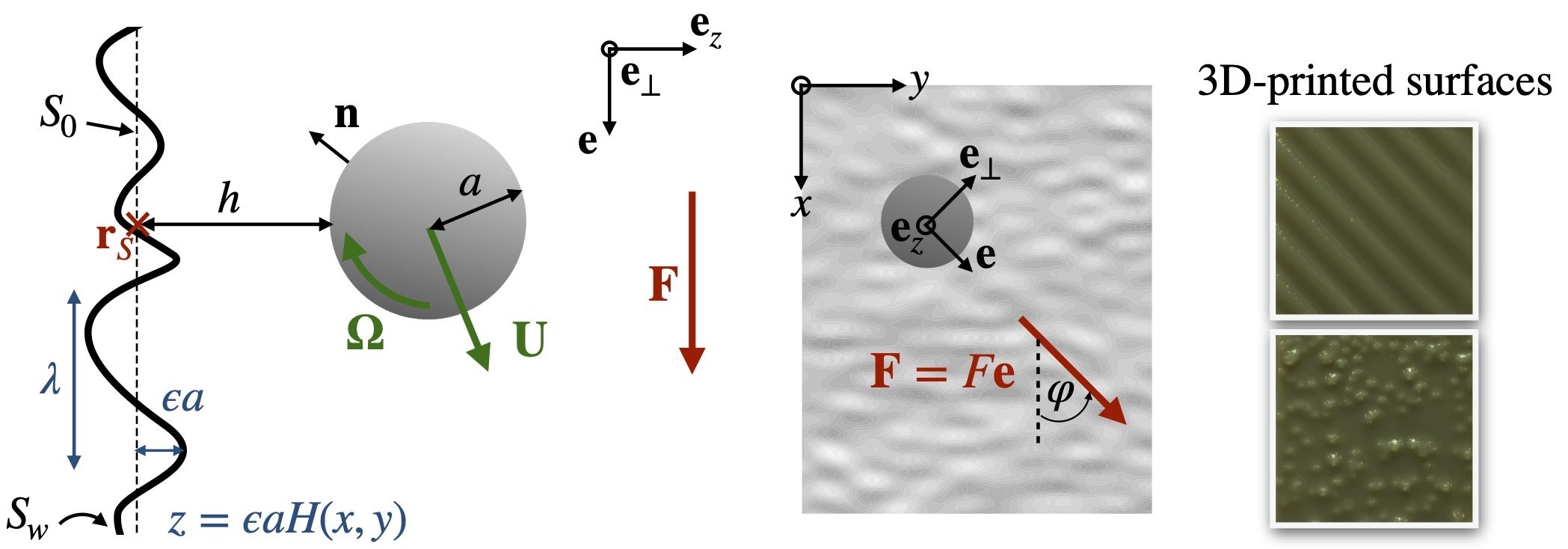
Particle motion nearby rough surfaces
Researchers: Christina Kurzthaler, Danielle Chase, Lailai Zhu (National University of Singapore), Amir A. Pahlavan, and Howard A. StoneAbstract: We study the hydrodynamic coupling between particles and solid, rough boundaries characterized by random surface textures. Using the Lorentz reciprocal theorem, we derive analytical expressions for the grand mobility tensor of a spherical particle and find that roughness-induced velocities vary nonmonotonically with the characteristic wavelength of the surface. In contrast to sedimentation near a planar wall, our theory predicts continuous particle translation transverse and perpendicular to the applied force. Most prominently, this motion manifests itself in a variance of particle displacements that grows quadratically in time along the direction of the force. This increase is rationalized by surface roughness generating particle sedimentation closer to or farther from the surface, which entails a significant variability of settling velocities. We currently work on a quantitative comparison between our theoretical predictions and experiments of particles sedimenting nearby 3D-printed periodic and randomly structured surfaces.
Publications: C. Kurzthaler, L. Zhu, A. A. Pahlavan, and H.A. Stone, Phys. Rev. Fluids, 5, 082101(R) (2020)
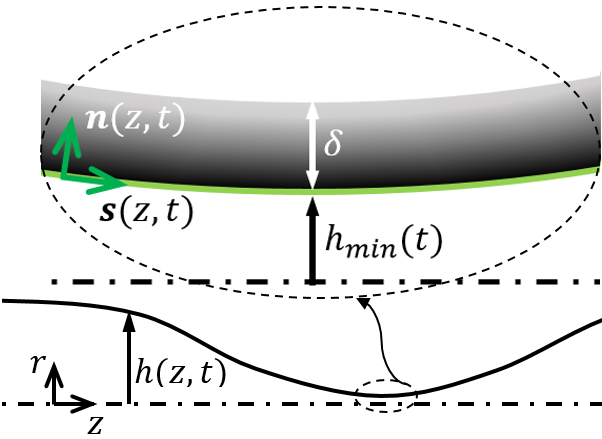
Pinch-off of liquid jets close to the continuum limit
Researchers: Francisco Cruz-Mazo and Howard A. StoneAbstract: We focus on the behavior of liquid jets, their instability, and subsequent rupture when the minimum radial length eventually vanishes, and then classical continuum descriptions would start to fail. Indeed, this drastic topological transformation may affect the validity of the classical inertial-viscous pinch-off models beyond a specific scale where the finite interface appears on the scene and whose study is out of reach of existing stochastic fluctuations approaches so far. We are working on how to reconcile both frameworks by finding a set of expanded self-similar properties of our physical model.
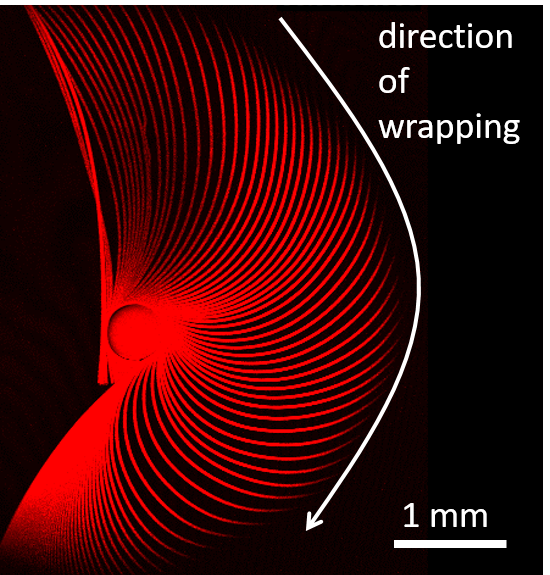
Electrostatic microfiber wrapping
Researchers: Janine K. Nunes, J. Li, I. M. Griffiths, Bhargav Rallabandi, J. Man, Howard A. StoneAbstract: We study the dynamics of the wrapping of a charged flexible microfiber around an oppositely charged curved particle immersed in a viscous fluid. The image shows an example of the overlay of the time sequence of this wrapping behavior. We observe that the wrapping behavior varies with the radius and Young’s modulus of the fiber, the radius of the particle, and the ionic strength of the surrounding solution. The trends in wrapping rate indicate that wrapping is primarily a function of the favorable interaction energy due to electrostatics and the unfavorable deformation energy needed to conform the fiber to the curvature of the particle. We perform an energy balance to predict the critical particle radius for wrapping, finding reasonably good agreement with experimental observations. In addition, we use mathematical modeling and observations of the deflected shape of the free end of the fiber during wrapping to extract a measurement of the Young’s modulus of the fiber. We evaluate the accuracy and potential limitations of this in situ measurement when compared to independent mechanical tests.
Publications: J. K. Nunes, J. Li, I. M. Griffiths, B. Rallabandi, J. Man, H. A. Stone, submitted (2020)
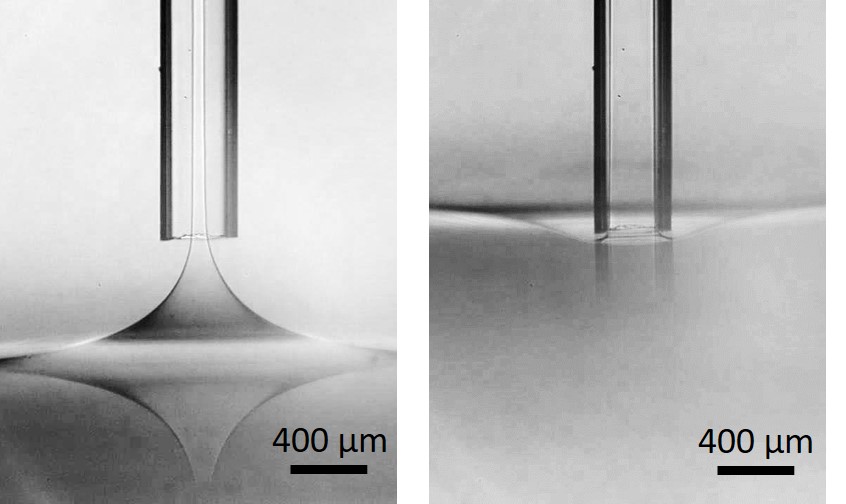
The Regime Map and Triple Point in Selective Withdrawal
Researchers: Zehao Pan, Janine K. Nunes, Howard A. StoneAbstract: Entrainment in selective withdrawal occurs when both the top and bottom phases are withdrawn through a capillary tube oriented perpendicular to a flat gravitationally separated liquid-liquid interface. The tube introduces two distinct features to the conditions for fluid entrainment. First, the ratio of the two phases being withdrawn is affected by the region of influence of the flow upstream of the tube's orifice. Second, a minimum withdrawal flow rate must be reached for entrainment regardless of the distance between the interface and the tube. We show that these phenomena can be understood based on the Reynolds number that governs the external flow field around the capillary tube and the capillary number that regulates the effect of the viscosity and capillarity.
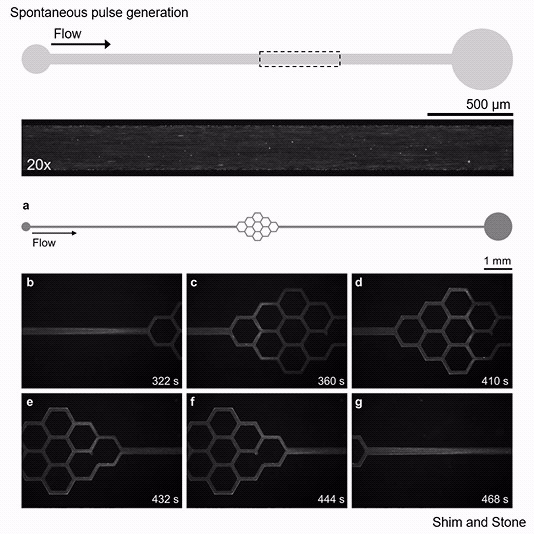
Spontaneous pulse generation in channel flow of a particle suspension
Researchers: Suin Shim and Howard A. StoneAbstract: We present experiments demonstrating the spontaneous generation and traveling of a colloidal pulse in a steady channel flow. When deionized (DI) water with suspended positively-charged particles flows steadily through a single channel, a pulse (unexpected focusing) of particles is generated, which then flows through the channel at a slower speed than the mean flow velocity. With detailed experimental investigations and quantified results, we rationalize our observations by considering CO2 driven diffusiophoresis. The concentration gradient of ions in the liquid phase is created by the leakage of CO2 through the permeable PDMS walls. Mathematical models for early stage particle focusing and the traveling pulse will be compared with the experimental observations.
Publications: S. Shim and H. A. Stone, “CO2-leakage-driven diffusiophoresis causes spontaneous accumulation of charged materials in channel flow” Proc. Natl. Acad. Sci. U.S.A.2020 117 (42) 25985-25990
Conference presentations:
Spontaneous pulse generation in a steady channel flow of a colloidal suspension – the role of dissolved gas, 2017 APS DFD Meeting, Nov. 2017, Denver CO
Spontaneous pulse generation in a steady channel flow of a colloidal suspension, APS March Meeting 2019, Mar. 2019, Boston MA
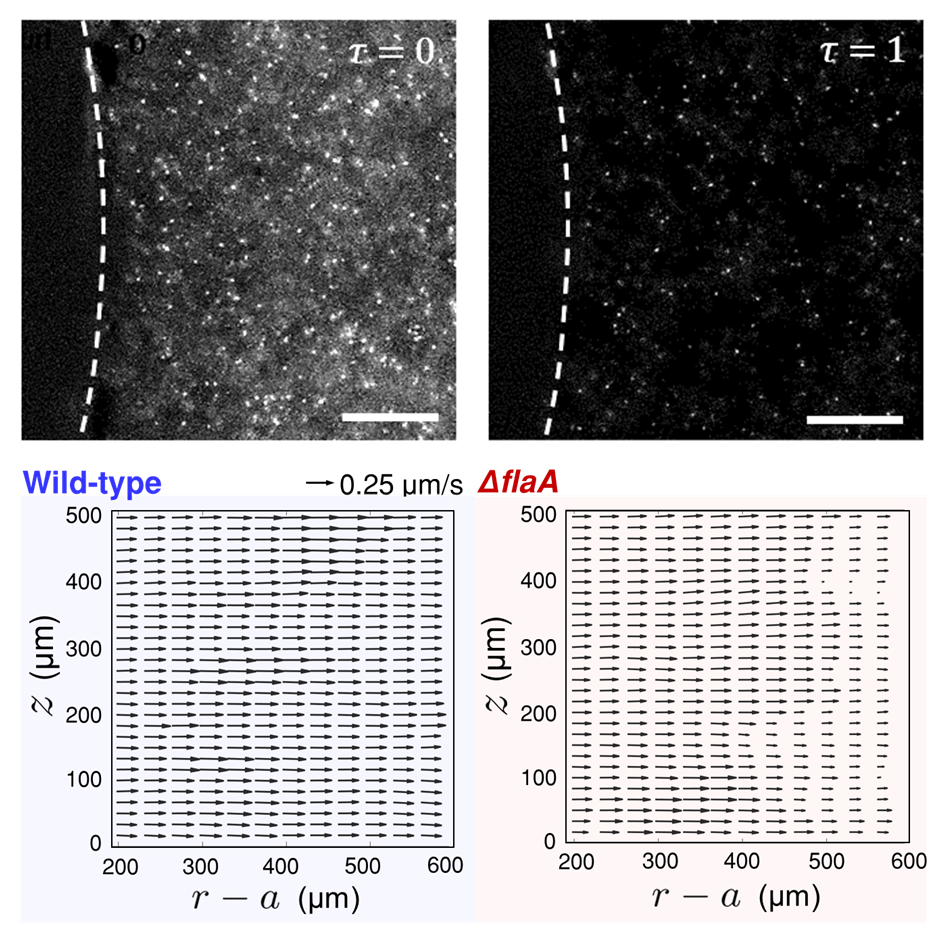
CO2-driven diffusiophoresis for removal of bacteria
Researchers: Suin Shim, Sepideh Khodaparast, Ching-Yao Lai, Jing Yan, Jesse T. Ault, Bhargav Rallabandi, Orest Shardt, and Howard A. StoneAbstract: CO2 dissolution in an aqueous phase can create concentration gradient of H+ and HCO3- ions. We demonstrate diffusiophoresis of bacterial cells in a Hele-Shaw geometry with circular symmetry. Directional migration of the wild-type V. cholerae and a mutant lacking Flagella shows that the motion is diffusiophoresis, not a CO2-driven chemotaxis. Diffusiophoresis of S. aureus reduces cell adhesion to a surface, and the exclusion of P. aeruginosa lasts > 11 hr after CO2 is turned off. Diffusiophoresis of bacteria can prevent surface contamination or infection by reducing the population of the cells approaching an interface.
Publications: S. Shim, S. Khodaparast, C.-Y. Lai, J. Yan, J. T. Ault, B. Rallabandi, O. Shardt and H. A. Stone, "CO2-driven diffusiophoresis for removal of bacteria" arXiv:2009.07081 (16 Sep. 2020)
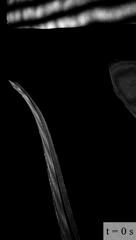
Self-Similar Draining near a Vertical Edge
Researchers: N. Xue, H. A. StoneAbstract: Self-similarity is a fundamental idea in physics, where it is usually discussed in the context of problems with two independent variables that occur in a solution in a ratio involving a power law. Here we provide an example with three independent variables where the self-similar structure involves a single ratio of the three variables. In particular, we report experiments of the three-dimensional (3D) shape of a gravitationally draining liquid film near a vertical edge, as occurs when a liquid film drains on a vertical plate: the film becomes nonuniform in space and time near the vertical edge (see attached image). A mathematical model of the drainage involves a nonlinear partial differential equation (PDE) involving time and two independent (space) variables. We identify a self-similar solution that converts the problem into an ordinary differential equation. Interferometry is performed to measure the film thickness as a function of position and time, and the results are in excellent agreement with the theoretical predictions. This study provides a new scaling law for understanding and estimating draining films with edge configurations, and provides new insights and methods for treating self-similar systems.
Publications: N. Xue, H. A. Stone, "Self-Similar Draining near a Vertical Edge", Phys. Rev. Lett., vol. 125, Aug 2020, pp. 064502.
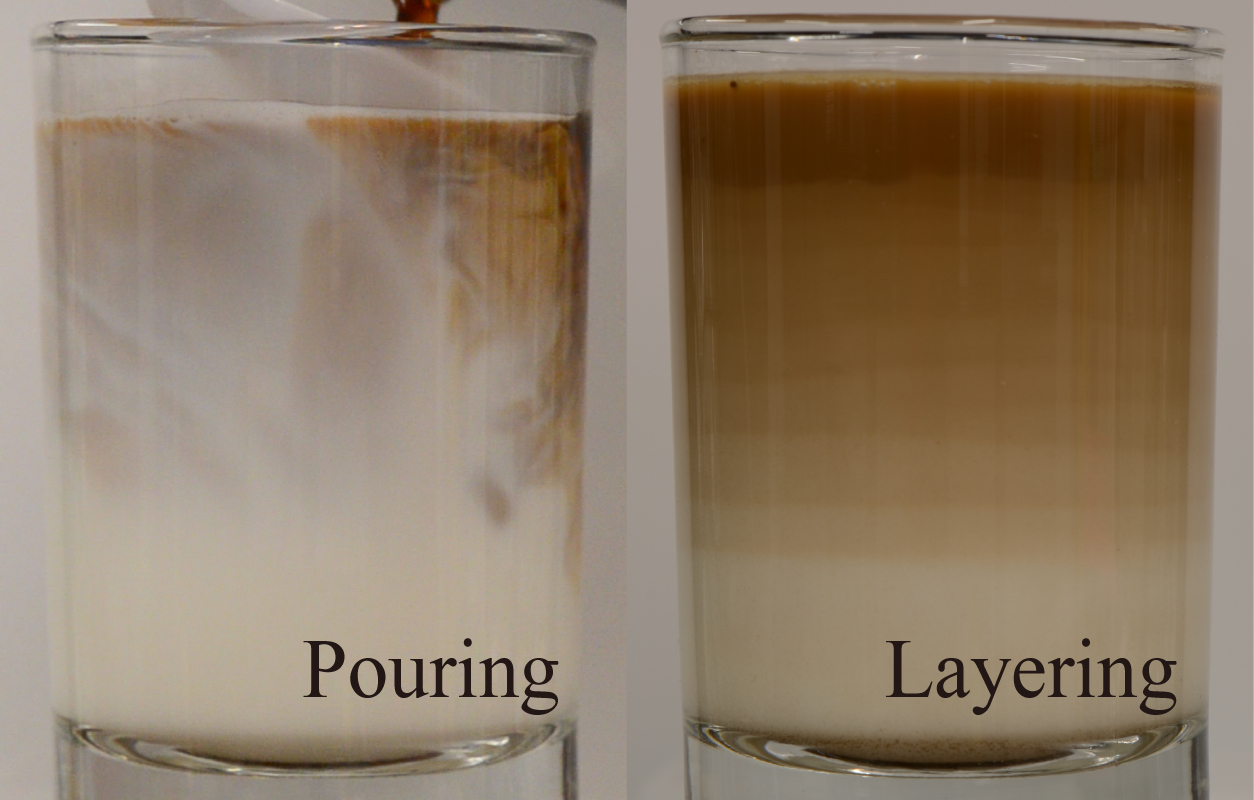
Laboratory layered latte
Researchers: N. Xue, S. Khodaparast, L. Zhu, J. K. Nunes, H. Kim, H. A. StoneAbstract: Inducing thermal gradients in fluid systems with initial, well-defined density gradients results in the formation of distinct layered patterns, such as those observed in the ocean due to double-diffusive convection. In contrast, layered composite fluids are sometimes observed in confined systems of rather chaotic initial states, for example, lattes formed by pouring espresso into a glass of warm milk. Here, we report controlled experiments injecting a fluid into a miscible phase and show that, above a critical injection velocity, layering emerges over a time scale of minutes. We identify critical conditions to produce the layering, and relate the results quantitatively to double-diffusive convection. Based on this understanding, we show how to employ this single-step process to produce layered structures in soft materials, where the local elastic properties vary step-wise along the length of the material.
Publications: N. Xue, S. Khodaparast, L. Zhu, J. K. Nunes, H. Kim, H. A. Stone, "Laboratory layered latte", Nature Communications, vol. 8, no. 1, 2017, pp. 196;
N. Xue, S. Khodaparast and H. A. Stone, "Fountain mixing in a filling box at low Reynolds numbers", Phys. Rev. Fluids, vol. 4, Feb 2019, pp. 024501.

Formation, Rupture, and Healing of an Annular Viscous Film
Researchers: Fan Yang and Howard A. StoneAbstract: When a thin horizontal liquid film is formed, it is gravitationally unstable and drips: the film falls, forming an annulus and eventually yielding an encapsulated bubble. This is in contrast with conventional jet and drop breakup, which usually develops into cylindrical liquid columns. The annulus initially contracts due to surface tension, until the air column inside ruptures and the inner surface forms a retracting tip, which will further translate along and subsequently heal the whole annulus. During the healing process, air is driven out of the narrow gap, part of which is propelled into the droplet and consequently forms an entrained bubble. A one-dimensional model is derived for the thinning dynamics, which shows good agreement with experimental measurements and predicts that the thinning dynamics is universal. The shape of the tip is documented to be conical, and the cone angle is invariant as the translating tip heals the annulus.
Publications: Formation, Rupture, and Healing of an Annular Viscous Film, PRL, 124:224501, 2020
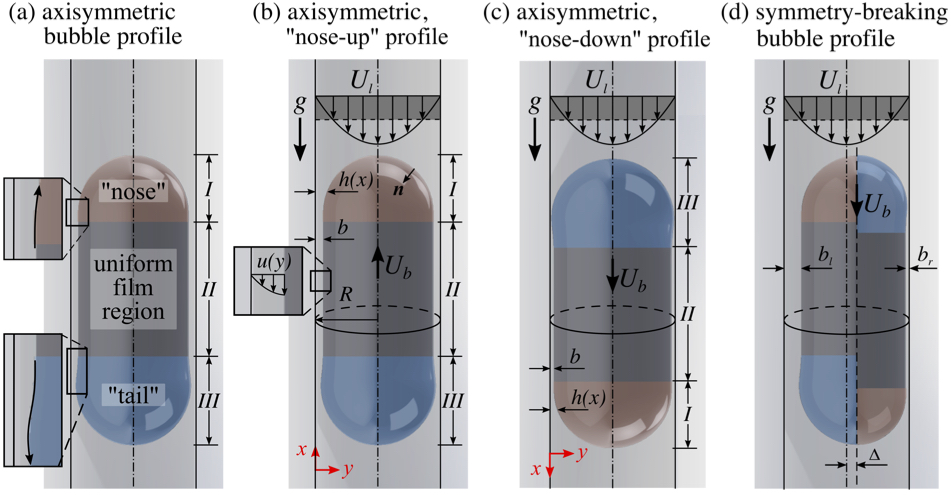
Non-unique bubble dynamics in a vertical capillary with an external flow
Researchers: Yu, Y. E., Magnini, M., Zhu, L., Shim, S., & Stone, H. A.Abstract: We study bubble motion in a vertical capillary tube under an external flow. Bretherton (1961) showed that, without external flow, a bubble can spontaneously rise when the Bond number (Bo ≡ ρgR2/γ) is above the critical value 0.842. It was then shown by Magnini et al. (2019) that the presence of an imposed liquid flow, in the same (upward) direction as buoyancy, accelerates the bubble and thickens the liquid film around it. In this work we carry out a systematic study of the bubble motion under a wide range of external flows, focusing on the inertialess regime with Bo above the critical value. We show that a rich variety of bubble dynamics occur when an external downward flow is applied, opposing the buoyancy-driven rise of the bubble. We reveal the existence of a critical capillary number of the external downward flow (Cal ≡ μUl/γ) at which the bubble arrests and changes its translational direction. Depending on the relative direction of gravity and the external flow, the film thickness follows two distinct solution branches. The results from theory, experiments and numerical simulations confirm the existence of the two solution branches and reveal that the two branches overlap over a finite range of Cal, thus suggesting non-unique, history-dependent solutions for the steady-state film thickness under the same external flow conditions. Furthermore, inertialess symmetry-breaking shape profiles at steady state are found as the bubble transits near the tipping points of the solution branches, which are shown both in experiments and numerical simulations.
Publications: Yu, Y. E., Magnini, M., Zhu, L., Shim, S., & Stone, H. A. (in press). Non-unique bubble dynamics in a vertical capillary with an external flow. Journal of Fluid Mechanics.
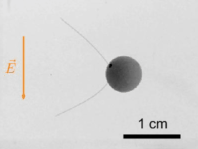
Flagellated Quincke swimmers at low Reynolds number
Researchers: Lailai Zhu, Endao Han, Joshua W. Shaevitz, and Howard A. StoneAbstract: Flagella and cilia play an important role in biology, which motivates the idea of functional mimicry as part of bioinspired applications. Nevertheless, it remains challenging to drive their artificial counterparts via a steady, homogeneous stimulus. Combining theory, simulations, and experiments, we demonstrate a strategy to achieve this goal by exploiting an elasto-electro-hydrodynamic instability based on the Quincke rotation. Our Quincke swimmers are comprised of a spherical particle and one or two elastic fibers. In a uniform and static electric field, the swimmers exhibit different forms of motion, including a self-oscillatory state, and they each lead to a distinct trajectory in space. Our results demonstrate a new method to generate, and potentially control, the locomotion of artificial flagellated swimmers at low Reynolds numbers.
Publications: L. Zhu and H. A. Stone, Physical Review Fluids, 4(6):1-7, 2019;
L. Zhu and H. A. Stone, Journal of Fluid Mechanics, 888:A311-A3135, 2020;
E. Han, L. Zhu, J. W. Shaevitz, and H. A. Stone, submitted.
Previous Research
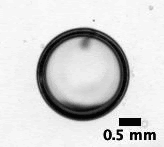
Bursting bubbles at an oil-covered interface
Researchers: Feng, J., Roché, M., M., Vigolo, Arnaudov, L.N., Stoyanov, S.D., Gurkov, T.D., Tsutsumanova, G.G., Stewart P.S., Kimpton L.S., Griffiths I.M., Nunes, J.K., Shin, S., Yan, J., Kong, Y.L., Prud’homme, R.K., Arnaudov, L.N., Stoyanov, S.D., Muradoglu, M., Kim, H., Ault, J.T. and Stone, H.A.Abstract: Bursting of bubbles at an air/liquid interface is a familiar occurrence relevant to foam stability, cell cultures in bioreactors and ocean-atmosphere mass transfer. In the latter case, bubble bursting leads to the dispersal of sea-water aerosols in the surrounding air. Here we show that bubbles bursting at a compound air/oil/water-with-surfactant interface can disperse submicrometre oil droplets in water. Dispersal results from the detachment of an oil spray from the bottom of the bubble towards water during bubble collapse. We provide evidence that droplet size is selected by physicochemical interactions between oil molecules and the surfactants rather than by hydrodynamics. We demonstrate the unrecognized role that this dispersal mechanism may play in the fate of the sea surface micro-layer and of pollutant spills by dispersing petroleum in the water column. Finally, our system provides an energy-efficient route, with potential upscalability and wide applicability, for applications in drug delivery, food production and materials science.
Publications: Feng, J., Roché, M., Vigolo, D., Arnaudov, L.N., Stoyanov, S.D., Gurkov, T.D., Tsutsumanova, G.G. and Stone, H.A., 2014. Nature Physics, 10(8), 606-612;
Stewart P.S., Feng J., Kimpton L.S., Griffiths I.M. and Stone, H.A., 2015. Journal of Fluid Mechanics, 777, 27-49. Feng, J., Nunes, J.K., Shin, S., Yan, J., Kong, Y.L., Prud’homme, R.K., Arnaudov, L.N., Stoyanov, S.D. and Stone, H.A. 2016. Advanced Materials, 28(21), 4047-4052;
Feng, J., Muradoglu, M., Kim, H., Ault, J.T. and Stone, H.A., 2016. Journal of Fluid Mechanics, 807, 324-352.
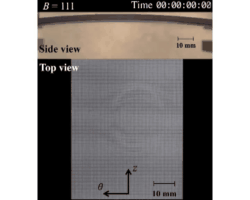
Curvature suppresses the Rayleigh-Taylor instability
Researchers: P. H. Trinh, H. Kim, N. Hammoud, P. D. Howell, S. J. Chapman, and H. A. StoneAbstract: The dynamics of a thin liquid film on the underside of a curved cylindrical substrate is studied. The evolution of the liquid layer is investigated as the film thickness and the radius of curvature of the substrate are varied. A dimensionless parameter (a modified Bond number) that incorporates both geometric parameters, gravity, and surface tension is identified, and allows the observations to be classified according to three different flow regimes: stable films, films with transient growth of perturbations followed by decay, and unstable films. Experiments and linear stability theory confirm that below a critical value of the Bond number curvature of the substrate suppresses the Rayleigh-Taylor instability.
Publications: P. H. Trinh, H. Kim, N. Hammoud, P. D. Howell, S. J. Chapman, and H. A. Stone, Phys. Fluids 26, 051704 (2014).
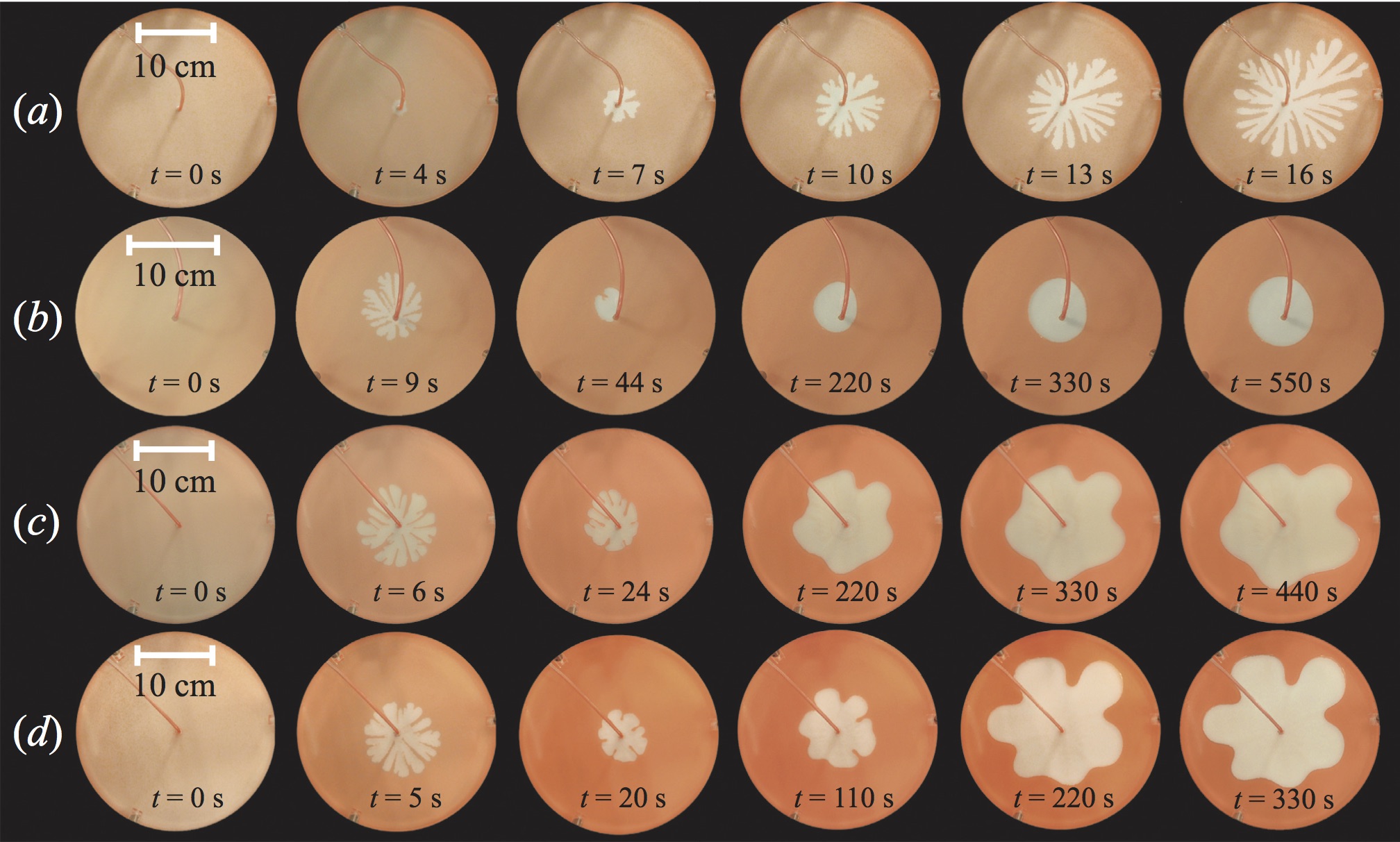
Control viscous fingering using time-dependent strategies
Researchers: Z. Zheng, H. Kim, and H. A. StoneAbstract: Control and stabilization of viscous fingering of immiscible fluids impacts a wide variety of pressure-driven multiphase flows. We report theoretical and experimental results on a time-dependent control strategy by manipulating the gap thickness b(t) in a lifting Hele-Shaw cell in the power-law form b(t) = b1t1/7. Experimental results show good quantitative agreement with the predictions of linear stability analysis. By choosing the value of a single time-independent control parameter, we can either totally suppress the viscous fingering instability or maintain a series of nonsplitting viscous fingers during the fluid displacement process. In addition to the gap thickness of a Hele-Shaw cell, time-dependent control strategies can, in principle, also be placed on the injection rate, viscosity of the displaced fluid, and interfacial tension between the two fluids.
Publications: Z. Zheng, H. Kim, and H. A. Stone, Phys. Rev. Lett. 115, 174501 (2015).
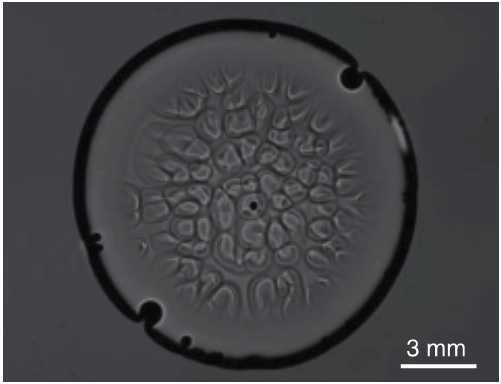
Benard-Marangoni instability driven by moisture absorption
Researchers: S. Shin, I. Jacobi, and Howard StoneAbstract: Glycerol is a viscous liquid widely used in industry and known for its strong hygroscopic nature. While this unusual property has been well documented from the perspective of solution chemistry, its impact on the mechanical properties of glycerol remains largely unknown. We show that a Benard-Marangoni instability in pure glycerol can be spontaneously driven by absorption of water vapor. Even under standard laboratory conditions, ambient humidity is sufficient to drive distinct Benard-Marangoni convection cells for hours. Such an instability is a consequence of diffusive vapor transport process and competition between solutal and thermal Marangoni forces.
Publications: S. Shin, I. Jacobi and H. A. Stone, EPL 113, 24002 (2016).

Triggering and inhibiting splashes with tangential velocity
Researchers: J.C. Bird, Scott Tsai, and Howard StoneAbstract: A drop impacting a smooth, solid, dry surfaces form a radially spreading lamella and sometimes results in splashing. In industrial and natural processes, it is common for the drops to impact the surface on an angle or while the surface is moving, yet previous studies mostly focused on the perpendicular impact of drops onto surfaces. We show that the tangential component of the impact can act to trigger or inhibit a splash, and we develop a model to predict this type of behavior. Our model agrees with previous experimental data and with our observations of the effects of tangential velocity.
Publications: J. C. Bird, S. H. Tsai, and H. A. Stone, New Journal of Physics 11 (2009).
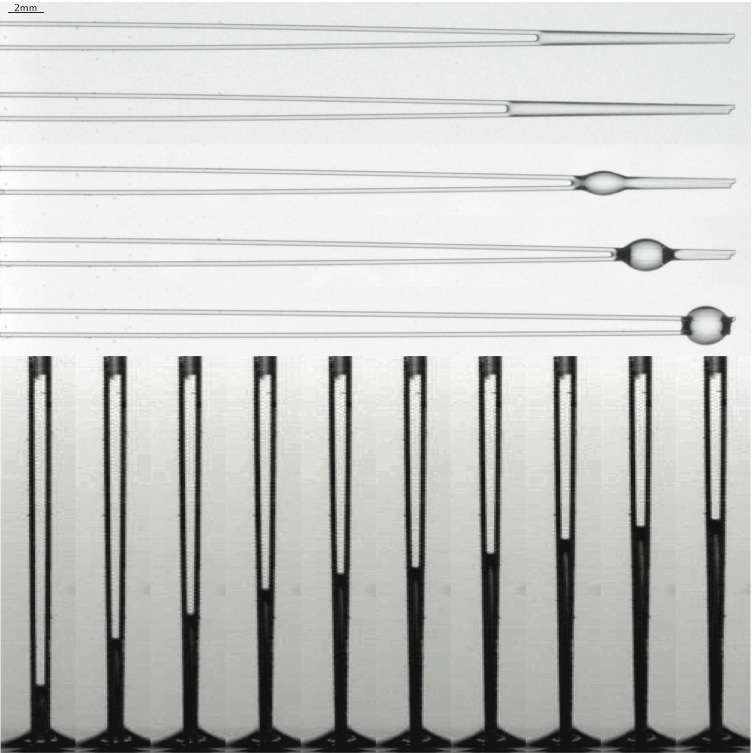
Elastocapillarity
Researchers: C. Duprat, S. Protiere, J. M. Aristoff, and H. A. StoneAbstract: The surface-tension-driven coalescence of flexible structures is relevant to a number of engineering and biological systems, such as the clumping of hair, the failure of micro devices during wet lithography, or more generally whenever a liquid-air interface is moving through a deformable media. We study the dynamics of wetting of flexible boundaries with a combination of experiments, scaling arguments and theory. We consider three model systems. We investigate the rise and the spontaneous imbibition of a liquid between flexible sheets clamped at one end, and free to deflect at the other end, and study how the deformation of the sheets affects the meniscus speed and entraps the liquid. We also study the behavior of a single drop on a pair of flexible fibers and show that, due to a combination of capillary and elasticity effects, the drop spreads into a long liquid column, and there is an optimal volume at which the wetted length is maximum.
Publications: J. M. Aristoff, C. Duprat and H. A. Stone, Int. J. Non-Linear Mech. 46 (2011).
C. Duprat, J. M. Aristoff and H. A. Stone, J. Fluid Mech. 679 (2011).
C. Duprat, S. Protiere, A. Y. Beebe and and H. A. Stone, Nature 482 (2012).
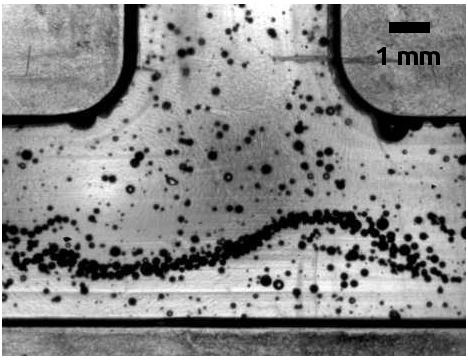
Bubbles dancing in a vortex: trapping air at a T-junction
Researchers: D. Vigolo, S. Radl, and H. A. StoneAbstract: An unusual phenomenon occurs to low density material, and in particular air bubbles, entrained in a fluid when flowing through a T-junction. For a range of Reynolds numbers, the flow develops two symmetric vortices. Air bubbles are forced to the center of the vortex due to the centrifugal force and are then "trapped", i.e. they accumulate inside the vortex. Bubbles eventually oscillate (i.e. "dance") in the vortex when the flow becomes unsteady. Experiments were conducted by generating air bubbles in a variety of T-junction devices. In addition, our 3D numerical simulations have revealed a gradient of pressure, similar to vortex breakdown, that drives the flow towards the center of the T-junction creating two recirculating zones, which trap air bubbles.
Publications: D. Vigolo, S. Radl, and H. A. Stone, PNAS, vol. 111, no. 13, mar 2014, pp. 4770-4775.
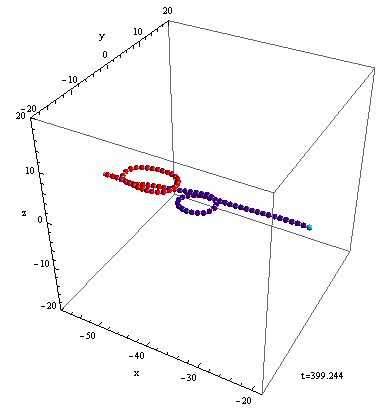
Using simple flows to tie knots in flexible fibers
Researchers: S. Kuei, K. Sadlej, and H. A. StoneAbstract: Flexible fibers, such as DNA and other polymer chains, have sometimes been found to contain knotted regions. While such fibers are not strict, closed knots, they exhibit similar characteristics; the formation of these `open knots' and the effects they have on material properties are the subject of current research. We investigate the possibility that simple flows can generate open knots in sufficiently long and flexible elastic fibers. Using the HYDROMULTIPOLE algorithm, which solves the multipole expansion of Stokes equations, we use numerical simulations to study the time evolution of a bead-spring model fiber in a shear flow. In certain systems, the characteristic tumbling motion of a fiber in shear flow will result in the formation of 3_1 and 5_1 knots, as identified by their Alexander polynomial knot invariants. Investigation of the key factors influencing knotting, as well as the mechanism of knotting, is ongoing.
Publications: S. Kuei, A. M. Słowicka, M. L. Ekiel-Jezewska, E. Wajnryb, H. A. Stone, New J. Phys., vol. 17, no. 5, may 2015, pp. 053009.
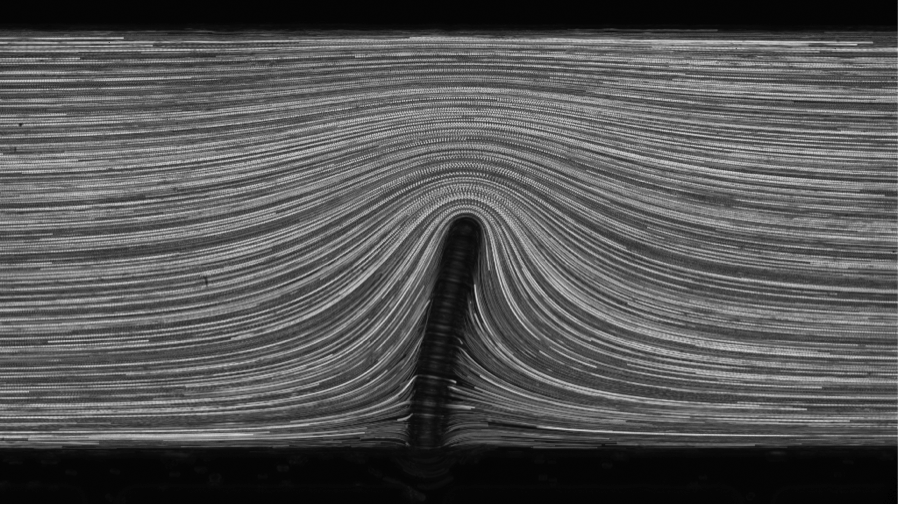
Bending of elastic fibers in viscous flow
Researchers: J. Wexler, P. Trinh, and H. A. Stone - With A. Lindner, O. du Roure, H. Berthet, N. Quennouz (ESPCI Parics) and H. E. Huppert (Cambridge)Abstract: A slender fibre, if flexible enough, will bend when immersed in a viscous flow. Confining walls affect the dynamics of a variety of real-world fibre systems ranging from industrial fibre suspensions to the biofilm streamers studied by our group. We study a model system that highlights the effect of confinement: a fibre is anchored in a thin channel, perpendicular to the direction of flow, and fluid is pumped through the channel, forcing the fibre to bend. There is a thin gap between the axis of the fibre and the channel wall, and we study the interplay between flow through this gap, flow around the fibre, and the corresponding effect on fibre deformation. Experiments are performed on a fibre that is polymerized directly in a microfluidic channel, and an analytical model is developed to explain the results.
Publications: J. S. Wexler, P. H. Trinh, H. Berthet, N. Quennouz, O. d. Roure, H. E. Huppert, A. Linder, H. A. Stone, J. Fluid Mech., vol. 733, sep 2013, pp. 684.
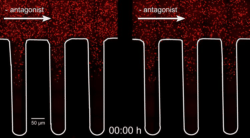
Local and global consequences of flow on bacterial quorum sensing
Researchers: M. K. Kim, F. Ingremeau, A. Zhao, B. L. Bassler, and H. A. StoneAbstract: To explore the health consequences of bacterial quorum sensing in the crypts, the researchers experimented with an antagonist to turn off quorum sensing in chambers colonized by methicillin-resistant S. aureus(MRSA), an antibiotic-resistant strain of bacteria that causes human infection. The left-side chamber contained no antagonist. In the right-side chamber, the antagonist molecules spread throughout the crevices, inactivating quorum sensing and indicating a potential strategy for alleviating MRSA virulence.
Publications: M. K. Kim, F. Ingremeau, A. Zhao, B. L. Bassler, H. A. Stone, Nat. Microbiol, vol. 1, no. 1, jan 2016, pp. 15005.
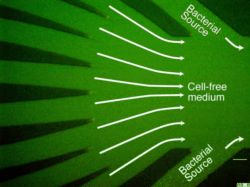
Colonization, competition, and dispersal of pathogens in fluid flow networks
Researchers: M. K. Kim, A. Siryaporn, Y. Shen, Z. Gitai, and H. A. StoneAbstract: To explore how pathogens spread in the host, the researchers designed a conversing branched flow network that mimic host environments such as lung or plant vasculature. Arrow indicates the directions that cell-free medium and bacterial cells were flowed. Wild-type P. aeruginosa (green) and its mutant pilTU (red) cells were initially seeded downstream of the conversing channels. Wild-type cells reached all upstream channels by 17 hours, while the pilTU cells remained the downstream regions. In this fluid flow environments, Wild-type P. aeruginosa cells attach to surfaces using type IV pili. These are localized to the bacterial cell poles such that upon attaching to the surface, flow causes the bacteria to orient with the pili pole pointed in the opposite direction of the flow. The repeated extension and retraction of pili using pilTU motors in this position drives Wild-type P. aeruginosa to move upstream along the surface.
Publications: A. Siryaporn, M. Kim, Y. Shen, H. Stone, Z. Gitai, Curr. Biol., vol. 25, no. 9, may 2015, pp. 1201–1207.
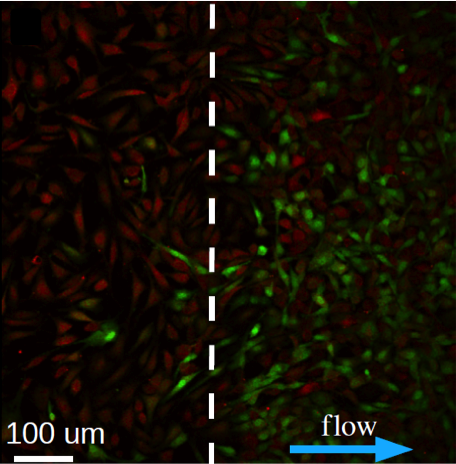
Collective behavior of chemosensing
Researchers: Bo Sun, Josephine Lembong, Guillaume Duclos and H. A. StoneAbstract: When cells are excited by external chemical stimulations, multiple intracellular signaling will take place to regulate necessary cellular functions. However, the chemosensing of individual cells usually come with large fluctuations, and the cells need to employ different strategies to make reliable decisions based on the noisy readouts. One such strategy we are exploring is to utilize inter-cellular communications. We found the cells self-organize their communication channels to form a network that demonstrates various critical behaviors such as long-range correlations and percolation transitions.
Publications: B. Sun, J. Lembong, V. Normand, M. Rogers and H. A. Stone, PNAS 109 (2012).
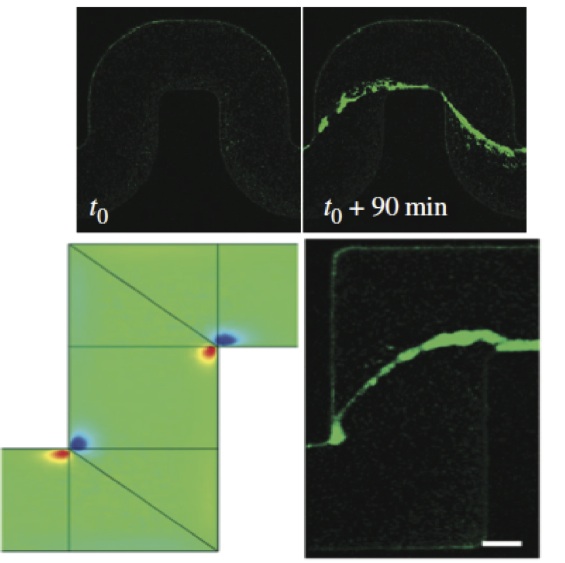
Biofilm streamers
Researchers: R. Rusconi, S. Lecuyer, L. Guglielmini, N. Autrusson, Y. Shen, K. Drescher and H. A. StoneAbstract: In the presence of a significant flow, mature multispecies biofilms often develop into long filamentous structures called streamers. We show that suspended thread-like biofilms steadily develop in zigzag microchannels. Numerical simulations of a low-Reynolds-number flow around the corners of the channel indicate the presence of a secondary vortical motion whose intensity is related to the bending angle of the turn. We demonstrate that the formation of streamers is directly proportional to the intensity of the secondary flow around the corners. In addition, we show that a model of an elastic filament in a two-dimensional corner flow is able to explain how the streamers can cross fluid streamlines and connect corners located at the opposite sides of the channel.
Publications: R. Rusconi, S. Lecuyer, L. Guglielmini, and H. A. Stone, J R Soc Interface 7 (2010).
R. Rusconi, S. Lecuyer, N. Autrusson, L. Guglielmini, and H. A. Stone Biophys. J. 100 (2011).
L. Guglielmini, R. Rusconi, S. Lecuyer, and H. A. Stone, J. Fluid Mech. 668 (2011).
N. Autrusson, L. Guglielmini, S. Lecuyer, R. Rusconi, and H. A. Stone Phys. Fluids 23 (2011).
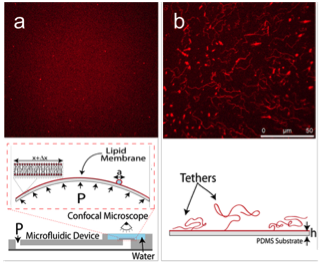
Confined lipid membranes
Researchers: M. Staykova, D. Holmes, C. Read, H. A. Stone - With M. Arroyo and M. Rahimi Lenji (Universitat Politecnica de Catalunya- Barcelona Tech, Spain)Abstract: Although the plasma membrane in cells is usually confined to other sub-cellular structures, the mechanics of confined membranes has rarely been addressed. To mimic the confinement we have developed a simplified membrane model, which couples a lipid bilayer to an elastic sheet (a). We have demonstrated that upon straining the confined membrane is able to regulate passively its area. In particular, by compressing the elastic support, the bilayer reduces its area in the plane by forming lipid protrusions (b); upon expansion, the protrusions are absorbed back into the planar bilayer (a). The shape of the protrusions, spherical and tubular, can be controlled by the strain and the liquid volume, available between the membrane and its support. Our observations closely reproduce membrane shapes and processes found in cells, thus suggesting that mechanics may be a simple and generic organizing principle.
Publications: M. Staykova and H. A. Stone, Communicative & Integrative Biology 4 (2011).
M. Staykova, D. P. Holmes, C. Read, and H. A. Stone, PNAS 108 (2011).
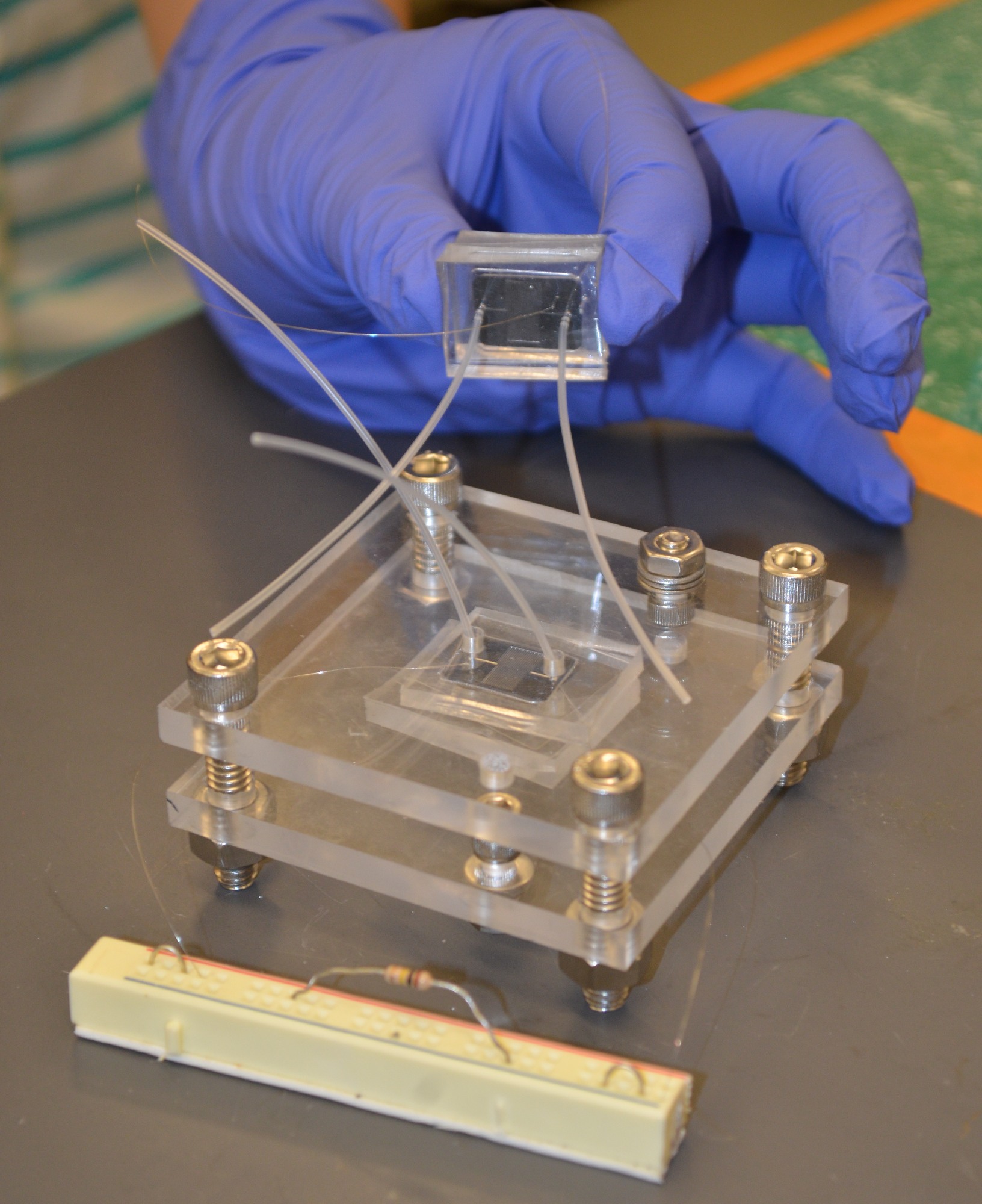
Development of a microfluidic microbial fuel cell
Researchers: D. Vigolo, T. Al-Housseiny, Y. Shen, T. DiChristina, H. A. Stone - with: F. O. Akinlawon, S. Al-Housseiny, R. K. Hobson, A. Sahu, K. BedkowskiAbstract: The power density output of microbial fuel cells (MFCs) is enhanced by optimizing the continuous flow of nutrient to obtain a constant rate of electricity production, and developing new electrodes material (optimization of surface roughness to increase the effective surface available to accommodate the bacteria). Preliminary results show how increasing the shear stress corresponds to increasing the output voltage generated by the MFCs up to an optimum flow rate. For higher flow rate the bacteria are discouraged to produce electricity and eventually are flushed away. A cheaper, membraneless microbial fuel cell design based on laminar co-flow is at the moment under investigation.
Publications: D. Vigolo, T. T. Al-Housseiny, Y. Shen, F. O. Akinlawon, S. T. Al-Housseiny, R. K. Hobson, A. Sahu, K. I. Bedkowski, T. J. DiChristina, H. A. Stone, Phys. Chem. Chem. Phys., vol. 16, no. 24, 2014, pp. 12535.
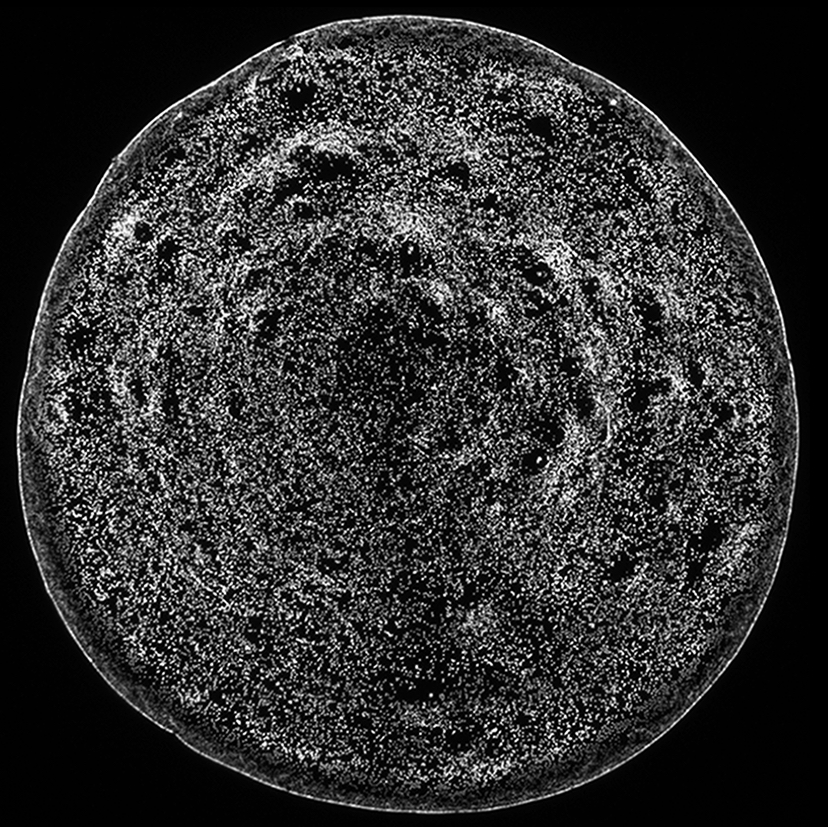
Controlled uniform coating induced by the interplay of Marangoni flows and surface-adsorbed macromolecules
Researchers: H. Kim, F. Boulogne, E. Um, I. Jacobi, and H. A. StoneAbstract: Surface coatings and patterning technologies are essential for various physicochemical applications. In this Letter, we describe key parameters to achieve uniform particle coatings from binary solutions. First, multiple sequential Marangoni flows, set by solute and surfactant simultaneously, prevent nonuniform particle distributions and continuously mix suspended materials during droplet evaporation. Second, we show the importance of particle-surface interactions that can be established by surface-adsorbed macromolecules. To achieve a uniform deposit in a binary mixture, a small concentration of surfactant and surface-adsorbed polymer (0.05 wt% each) is sufficient, which offers a new physicochemical avenue for control of coatings.
Publications: H. Kim, F. Boulogne, E. Um, I. Jacobi, E. Button, and H. A. Stone, Phys. Rev. Lett. 116, 124501 (2016).
News: B. Verberck, "Fluid dynamics: Spirited away," Nature Physics 12, 291 (2016)
B. Yirka, "Evaporated whisky inspires new type of coating technique," Phys.org (2016)
J. Kemsley, "Why whiskey doesn't put a ring on it," Chemical & Engineering News (2016)
M. Schirber, "Synopsis: Whisky-Inspired Coatings," Physics (2016)
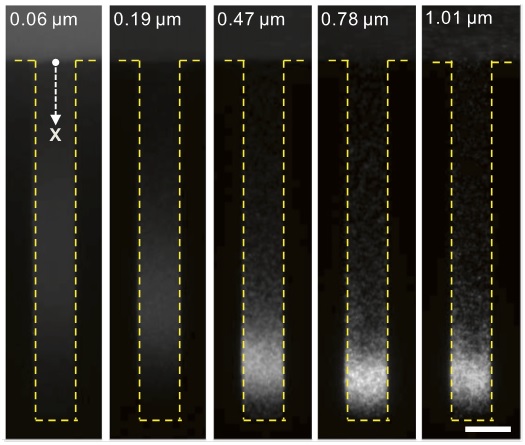
Controlling colloidal particles in confined geometries using solute gradients
Researchers: S. Shin, E. Um, B. Sabass, J. T. Ault, M. Rahimi, P. B. Warren, and H. A. StoneAbstract: Transport of colloids in confined geometries such as dead-end channels is involved in widespread applications including drug delivery and underground oil and gas recovery. In such geometries, Brownian motion may be considered as the sole mechanism that enables transport of colloidal particles into or out of the channels, but it is, unfortunately, an extremely inefficient transport mechanism for microscale particles. We explore the possibility of diffusiophoresis as a means to control the colloid transport in dead-end channels by introducing a solute gradient. We demonstrate that the transport of colloidal particles into the dead-end channels can be either enhanced or completely prevented via diffusiophoresis. In addition, we show that a combination of diffusiophoresis and Brownian motion leads to a strong size-dependent focusing effect such that the larger particles tend to concentrate more and reside deeper in the channel. Our findings have implications for all manners of controlled release processes, especially for site-specific delivery systems where localized targeting of particles with minimal dispersion to the nontarget area is essential.
Publications: S. Shin, E. Um, B. Sabass, J. T. Ault, M. Rahimi, P. B. Warren and H. A. Stone, Size-dependent control of colloid transport in dead-end channels via solute gradients, Proc. Natl. Acad. Sci. U.S.A. 113, 257–261 (2016).
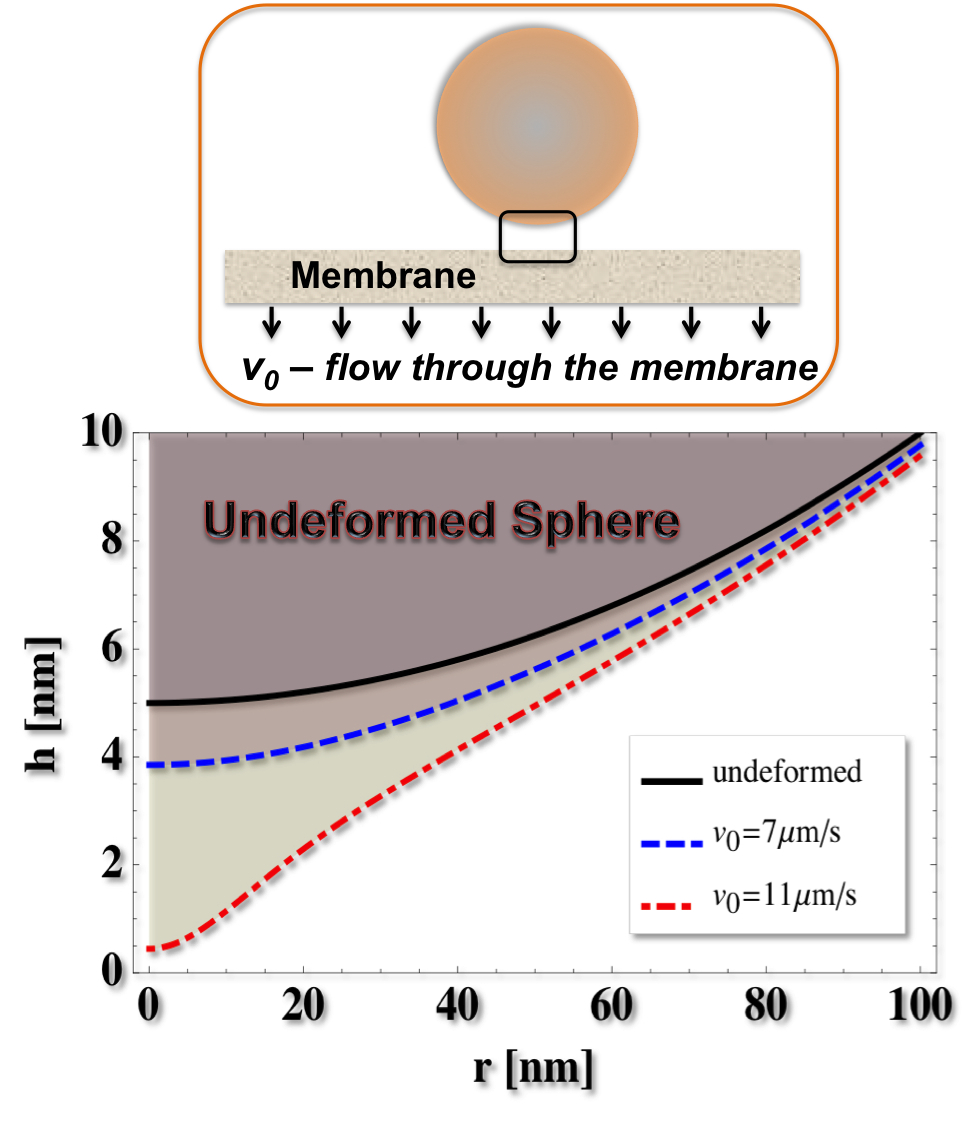
The elasto-hydrodynamic interaction between a particle and a permeable surface
Researchers: G. Ramon, H. Huppert, H. A. StoneAbstract: Deposition of colloidal material and bacteria is of major concern for membrane separation processes. A particle near a permeable surface experiences a hydrodynamic force, which increases as the surface becomes less permeable. This force may be orders of magnitude larger than the Stokes drag in an unbounded fluid. Shown here is a case where the particle is soft and deforms under this force, bringing it closer to the surface. This may have important implication for the adhesion propensity of soft particles onto membrane surfaces.
Publications: G. Z. Ramon, H. E. Huppert, J. R. Lister, H. A. Stone, Phys. Fluids, vol. 25, no. 7, 2013, pp. 073103.
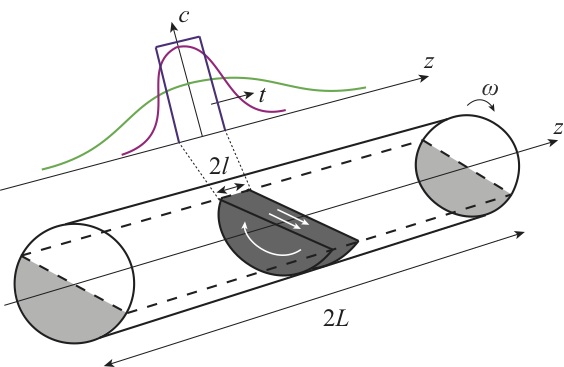
Anomalous scalings in the diffusion of granular materials
Researchers: I. C. Christov, H. A. StoneAbstract: Granular materials do not perform thermally driven Brownian motion, so diffusion is observed in such systems because agitation (flow) causes inelastic collisions between particles. It has been suggested that axial diffusion of granular matter in a rotating drum might be "anomalous" in the sense that the mean squared displacement of particles follows a power law in time with exponent less than unity. We have shown that such a "paradox" can be resolved using Barenblatt's theory of self-similar intermediate asymptotics. Specifically, we found an analytical expression for the instantaneous scaling exponent of a macroscopic concentration profile, as a function of the initial distribution. Then, we incorporated concentration-dependent diffusivity into the model, showing the existence of a crossover from an anomalous scaling (consistent with experimental observations) to a normal diffusive scaling at very long times.
Publications: I. C. Christov, H. A. Stone, PNAS 109 (2012).
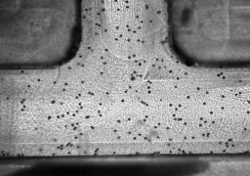
Particle-wall impacts in a T-junction
Researchers: D. Vigolo, I. Griffiths, S. Radl, H. A. StoneAbstract: The impacting event for a given system of particles entrained in a fluid is described in terms of the Reynolds number and the particle Stokes number. Experimental results for the impact in a T-junction are compared with the trajectories predicted by theoretical particle-tracing models for a range of configurations to determine the role of the viscous boundary layer in slowing down the particles and reducing the rate of collision with the substrate. In particular a 2D model based on a stagnation point flow is used together with detailed 3D numerical simulations.
Publications: D. Vigolo, I. M. Griffiths, S. Radl, and H. A. Stone. J. Fluid Mech., Submitted (2012).
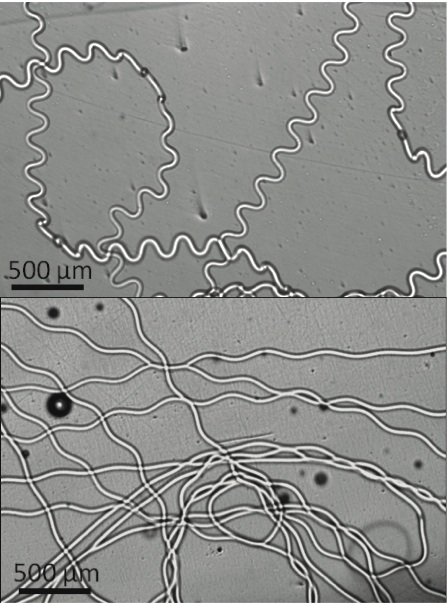
Microfluidic microfiber synthesis
Researchers: J. Nunes, K. Sadlej, J. I. Tam, H. Constantin and H. A. StoneAbstract: This project is focused on the development of a simple microfluidic method for the synthesis of polymeric microfibers of controlled length. We explored the use of valve actuation and UV light modulation to control the length of the microfibers. The valve-based approach, in particular, was developed to synthesize fibers with tunable lengths, which has not previously been demonstrated. We observed good, reproducible control of microfiber length as a function of the valve actuation frequency. We also focused on the synthesis of wavy or crimped polymeric microfibers using a microfluidic method. We trigger a buckling instability through the initiation of a polymerization reaction in a liquid jet when microchannel dimensions increase, and subsequently preserve the buckled morphology when the crosslinking reaction is completed. The resulting microfibers have highly uniform and reproducible morphologies. By changing the UV exposure location in the channel, as well as the flow rates, the degree of waviness of the microfibers can be controlled.
Publications: J. K. Nunes, K. Sadlej, J. I. Tam and H. A. Stone, Lab Chip, 12 (2012).
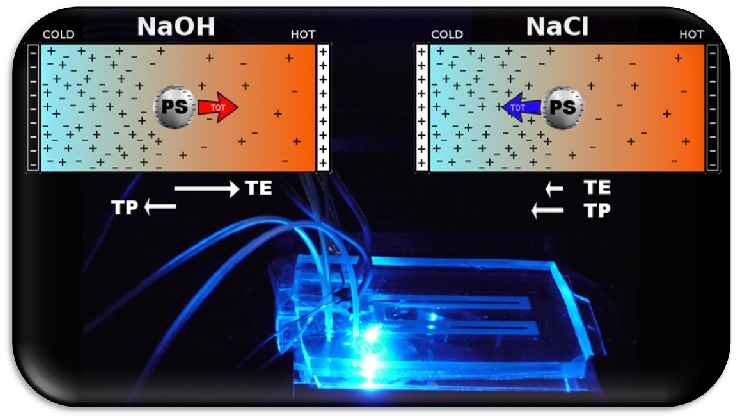
Temperature control and thermophoresis on-a-chip
Researchers: D. Vigolo, R. Rusconi, R. Piazza, and H. A. StoneAbstract: A new technique to control temperature along microchannels using a low viscosity, conductive epoxy as Joule heater was developped. By using this technique we were able to effectively keep a constant temperature or create a temperature gradient across a microfluidic channel. In the latter case we implemented a thermophoretic separator to actually separate (or drive) particles suspended in aqueous solution in a microfluidic lab-on-chip system.
Publications: D. Vigolo, R. Rusconi, R. Piazza, and H. A. Stone. Lab Chip, 10(6):795-798 (2010).
D. Vigolo, R. Rusconi, H. A. Stone, and R. Piazza. Soft Matter, 6(15):3489-3493 (2010).
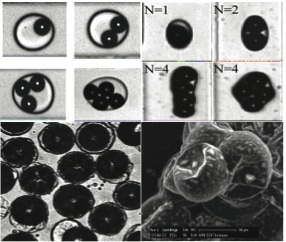
Encapsulation of bubbles
Researchers: J. Wan, S. Shim and H. A. StoneAbstract: We propose a microfluidic approach for the generation of water droplets containing a high volume fraction of gas bubbles and we provide a design principle for microbubble-based pressure sensing inside channels. We also present a microfluidic approach for the controlled encapsulation of individual gas bubbles in micrometer-diameter aqueous droplets with high gas volume fractions and demonstrate this approach to making a liquid shell, which serves as a template for the synthesis of hollow inorganic particles.
Publications: J. Wan, A. Bick, M. Sullivan, H. A. Stone. Adv. Mater. 20 (2008).
J. Wan, H. A. Stone, Soft Matter. 6 (2010).
J. Wan, H. A. Stone, Langmuir 28 (2012).
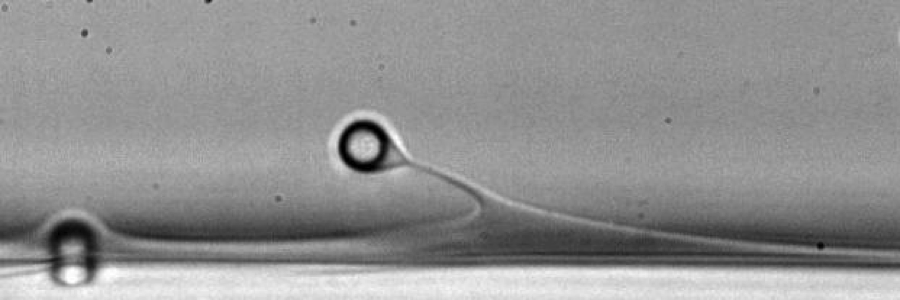
Control and manipulation of paramagnetic particles
Researchers: S. H. Tsai, J. S. Wexler, J. Wan, I. M. Griffiths, H. A. StoneAbstract: Magnetic forces are used to manipulate micron-sized paramagnetic beads in a microfluidic device, with applications in medicine and industry. By balancing the magnetic forces against fluid forces at the small scale (viscous drag and interfacial tension), we accomplish a variety of tasks on the serialized platform of a microfluidic device. It is shown that magnetic particles can be sorted by size transversely across a channel, by applying a magnetic field whose gradient is perpendicular to the direction of flow. If an immiscible interface is present at the center of a channel, a similar procedure may be used to coat spheres with a micron-sized coating, produce aggregates of controllable size, and to make measurements of ultra-low surface tension. Since magnetic particles may be functionalized to bind to various biological agents, these materials may be manipulated in a similar manner.
Publications: S. H. Tsai, I. M. Griffiths, and H. A. Stone. Lab on a Chip, 11 (2011).
S. H. Tsai, J. S. Wexler, J. Wan, and H. A. Stone. Applied Physics Letters, 99 (2011).
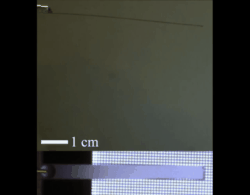
Rivulet flow over a flexible beam
Researchers: P. D. Howell, H. Kim, J. Robinson, M. G. Popova, and H. A. StoneAbstract: We study theoretically and experimentally how a thin layer of liquid flows along a flexible beam. The flow is modelled using lubrication theory and the substrate is modelled as an elastica which deforms according to the Euler-Bernoulli equation. A constant flux of liquid is supplied at one end of the beam, which is clamped horizontally, while the other end of the beam is free. As the liquid film spreads, its weight causes the beam deflection to increase, which in turn enhances the spreading rate of the liquid. This feedback mechanism causes the front position σ(t) and the deflection angle at the front ϕ(t) to go through a number of different power-law behaviours. For early times, the liquid spreads like a horizontal gravity current, with σ(t) =t4/5 and ϕ(t) = t13/5. For intermediate times, the deflection of the beam leads to rapid acceleration of the liquid layer, with σ (t) = t4 and ϕ (t) = t9. Finally, when the beam has sagged to become almost vertical, the liquid film flows downward with σ(t) = t and ϕ ~ π/2. We demonstrate good agreement between these theoretical predictions and experimental results.
Publications: P. D. Howell, J. Robinson, and H. A. Stone, J. Fluid Mech. 732, 190-213 (2013).
P. D. Howell, H. Kim, M. G. Popova, and H. A. Stone, J. Fluid Mech. accepted (2016).
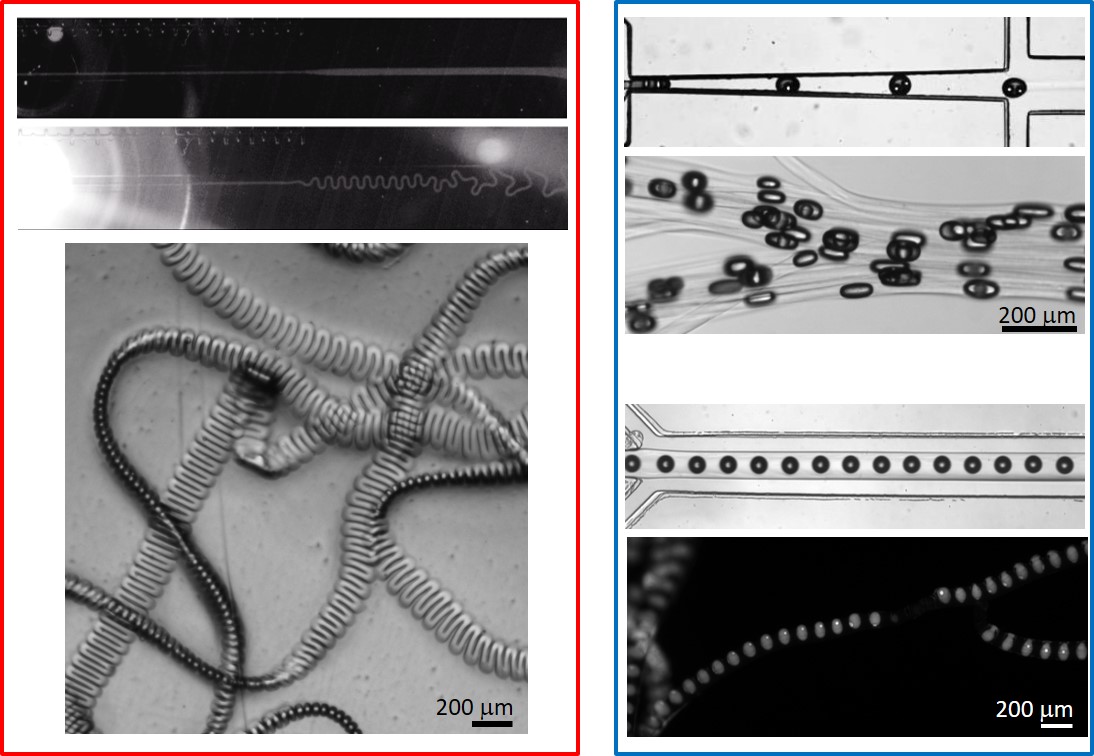
Microfluidic fabrication of microfibers
Researchers: J. K. Nunes, A. Grosskopf, and H. A. StoneAbstract: We are developing a family of multiphase microfluidic methods for the controlled synthesis of monodisperse polymeric microfibers where the size, shape, morphology, spatial composition, and the encapsulation of cargoes can be precisely tailored.
Publications: E. Um, J. K. Nunes, T. Pico, H. A. Stone, J. Mater. Chem. B, vol. 2, no. 45, oct 2014, pp. 7866-7871.
J. K. Nunes, C. Wu, H. Amini, K. Owsley, D. D. Carlo, H. A. Stone, Adv. Mater., vol. 26, no. 22, mar 2014, pp. 3712-3717.
J. K. Nunes, H. Constantin and H. A. Stone, Soft Matter, vol. 9, no. 16, 2013, pp. 4227.
J. K. Nunes, K. Sadlej, J. I. Tam, H. A. Stone, Lab. Chip, vol. 12, no. 13, 2012, pp. 2301.
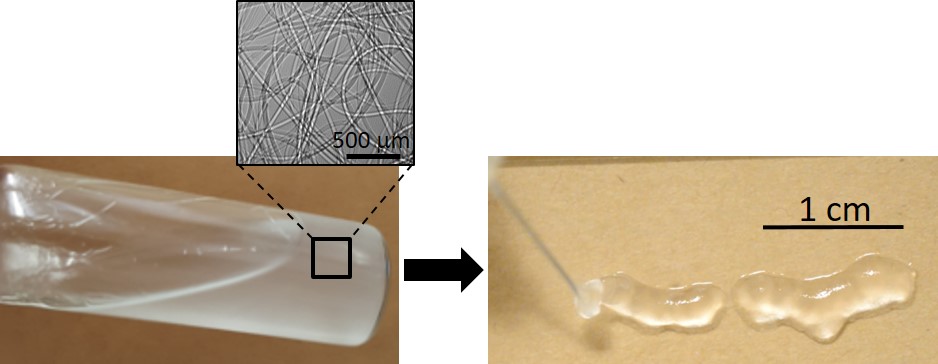
Flow-induced gelation of microfiber suspensions
Researchers: J. K. Nunes, A. Perazzo, and H. A. StoneAbstract: When subjected to flow conditions, such as extrusion from a needle, a suspension of flexible high aspect ratio fibers entangles irreversibly and forms a network. This flow-induced process is a simple mechanical approach to hydrogel formation that does not depend on chemical reactions. We study this phenomenon with shear rheology experiments and microscopic visualization. We propose that these microfiber suspensions are potentially useful material candidates for in situ scaffold fabrication in bioengineering applications.
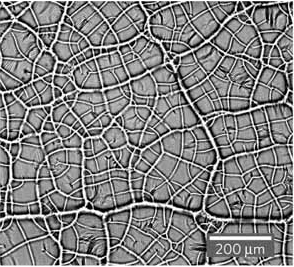
Hierarchical folding of elastic membranes
Researchers: P. Kim, M. Abkarian and H. A. StoneAbstract: Thin, layered materials develop surface undulations or wrinkles when they experience small compressive strain. This response is the result of a complex interplay between deformation of the top layer and its foundation. This periodic wrinkling find applications, e.g. in stretchable electronics but can also limit an application’s performance owing to delamination or cracking under load. In particular, because of curvature localization, finite deformations can cause wrinkles to evolve into folds. Using a two-layer polymeric system under biaxial compressive stress, we show that a repetitive wrinkle-to-fold transition generates a hierarchical network of folds during reorganization of the stress field. The folds delineate individual domains, and each domain subdivides into smaller ones over multiple generations. By modifying the boundary conditions and geometry, we demonstrate control over the final network morphology. We then exploit these wrinkles and deep folds to guide and retain light within the photoactive regions of photovoltaics and show substantial improvements in light harvesting efficiencies, particularly in the near-infrared region where light absorption is otherwise minimal.
Publications: P. Kim, M. Abkarian, and H. A. Stone, Nature Materials 10 (2011).
J. B. Kim, P. Kim, N. C. Pegard, S. J. Oh, C. R. Kagan, J. W. Fleischer, H. A. Stone, Y. L. Loo, Nature Photonics 6 (2012).
